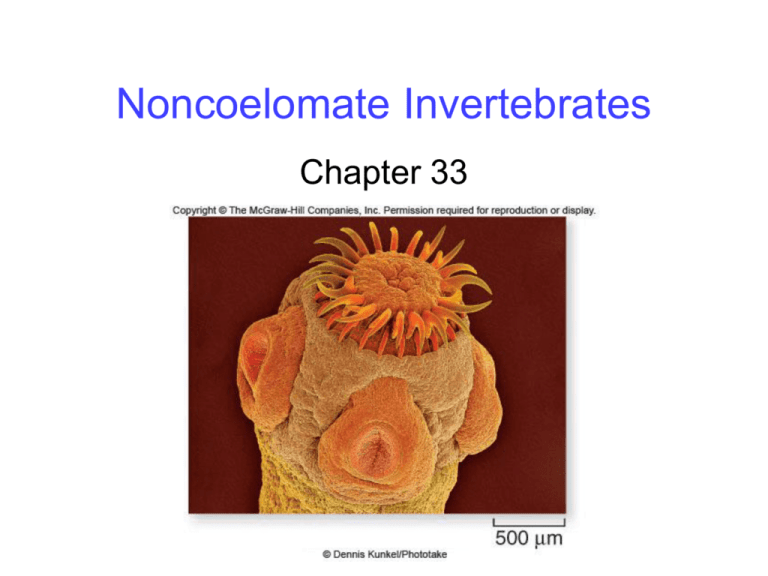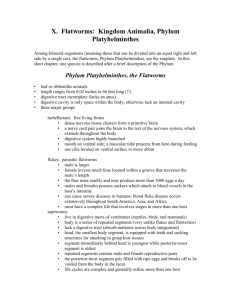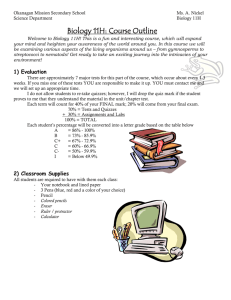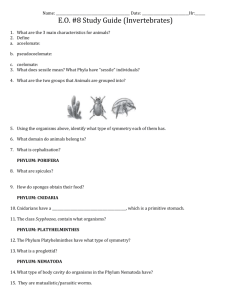Coelomates
advertisement

Noncoelomate Invertebrates Chapter 33 Invertebrate Phylogeny Revolution Scientists generally agree about the taxonomic classification of 36 animal phyla -They do disagree, however, about how these are interrelated Traditional reconstructions lump together phyla that share major features of body plan New reconstructions employ molecular comparisons of rRNA and other genes 2 Invertebrate Phylogeny Revolution Both old and new phylogenies agree that: -Porifera first separated from Eumetazoa -Among the eumetazoans, Cnidaria and Ctenophora branch out before Bilateria -Bilateria are divided into two groups: protostomes and deuterostomes Modern phylogeny differs radically from traditional phylogeny in construction of the protostome lineage 3 Invertebrate Phylogeny Revolution Traditionally, the branches of animals are based on the nature of the body cavity: -Acoelomates = Have no body cavity -Pseudocoelomates = Have pseudocoel -Coelomates = Have coelom Acoelomates and pseudocoelomates are always protostomes Coelomates are either protostomes or deuterostomes 4 Invertebrate Phylogeny Revolution 5 Invertebrate Phylogeny Revolution Ecdysozoans -Increase in size by molting their external skeletons -Two phyla have been particularly successful -Nematoda: pseudocoelomates -Roundworms -Arthropoda: coelomates -Insects, crustaceans, and others 6 Invertebrate Phylogeny Revolution 7 Parazoa Parazoans lack tissues, organs and a definite symmetry -However, they have complex multicellularity Sponges, phylum Porifera, are parazoans -Include marine and freshwater species -Larval sponges are free-swimming, but adults are anchored onto submerged objects 8 Parazoa Adult sponges are shaped like a vase Walls of the “vase” have three functional layers 9 Parazoa 1. Inner layer = Specialized flagellate cells called choanocytes, or collar cells 2. Central layer = Gelatinous, protein-rich matrix called the mesohyl 3. Outer layer = Protective epithelium Mesohyl may contain spicules and/or fibers of a tough protein called spongin -These strengthen the body of the sponge 10 Parazoa 11 Parazoa Sponges are “filter-feeders” -Beating of the choanocyte flagella draws water through numerous small pores -Brings in food and oxygen and expels wastes -Small organisms are filtered from the water, which flows through passageways -Eventually exits from the osculum 12 Parazoa Sponge reproduction -Asexual = Fragmentation -Sexual = Egg and sperm -Larval sponges use cilia for swimming -Settle down on a substrate -Transform into adults 13 Eumetazoa Eumetazoans are animals with distinct tissues Embryos have distinct layers -Inner endoderm = Forms the gastrodermis -Outer ectoderm = Forms the epidermis and nervous system -Middle mesoderm (Only in bilateral animals) -Forms the muscles 14 Eumetazoa Eumetazoans also evolved true body symmetry -Radiata = Exhibit radial symmetry -Phylum Cnidaria -Phylum = Ctenophora -Bilateria = Exhibit radial symmetry -All other animals 15 Phylum Cnidaria Cnidarians are nearly all marine -Bodies have distinct tissues but no organs Cnidarians are diploblastic -Ectoderm (epidermis) and endoderm (gastrodermis) -In between, a layer of gelatinous material (mesoglea) 16 Phylum Cnidaria Cnidarians are carnivores They have two basic body forms -Polyps = Cylindrical and sessile -Medusae = Umbrella-shaped and free-living 17 Fig. 33.5(left) 18 Phylum Cnidaria 19 Phylum Cnidaria Some cnidarians exist as either medusae or polyps, while others alternate between the two phases Polyps may reproduce sexually or asexually -Asexual reproduction occurs by budding and may produce a new polyp or medusae Medusae reproduce sexually -Form free-swimming larvae called planulae 20 21 Phylum Cnidaria Cnidarians have internal extracellular digestion -Digestion begins with extracellular fragmentation in the gastrovascular cavity -This is followed by phagocytosis and intracellular digestion Cnidarians have no circulatory, respiratory or excretory systems 22 Fig. 33.7 23 Phylum Cnidaria Cnidarians have unique specialized cells on their epidermis called cnidocytes The nematocyst is a special type of cnidocyte -Contains a small but powerful harpoon -Used for food acquisition and defense 24 Phylum Cnidaria 25 Four Classes of Cnidarians Hydrozoa (hydroids) Scyphozoa (jellyfish) Cubozoa (box jellyfish) Anthozoa (corals and sea anemones) 26 The Bilaterian Acoelomates The Bilateria are characterized by bilateral symmetry -Allowed for high levels of specialization Bilaterians are traditionally classified by the condition of their coelom -Acoelomates -Pseudoceolomates -Coelomates 27 Phylum Platyhelminthes The flatworms are soft-bodied animals -Many species are parasitic -Others are free-living Move by ciliated epithelial cells Have developed musculature 28 Phylum Platyhelminthes Flatworms have an incomplete digestive cavity with only one opening -Therefore, they cannot feed continuously Muscular contractions in the pharynx allows food to be ingested and torn into small bits Tapeworms (parasitic flatworms) lack digestive systems -Absorb food directly through body walls 29 Phylum Platyhelminthes Flatworms have an excretory and osmoregulatory system -Network of fine tubules runs through body -Flame cells located on the side branches -Primary function = water balance -Secondary function = excretion Metabolic wastes are excreted into the gut and eliminated through the mouth 30 Phylum Platyhelminthes Flatworms lack a circulatory system -Flattened body shape and highly-branched gut utilize diffusion They have a simple nervous system -Eyespot can distinguish light from dark Most are hermaphroditic -Undergo sexual reproduction -Also have capacity for asexual regeneration 31 Phylum Platyhelminthes 32 Phylum Platyhelminthes 33 Phylum Platyhelminthes -Turbellaria Free-living -Monogenea Parasitic -Trematoda -Cestoda 34 Phylum Platyhelminthes Class Turbellaria -Free-living flatworms -Recently shown to be polyphyletic -Found in freshwater, marine and even terrestrial environments 35 Phylum Platyhelminthes Classes Monogenea and Trematoda -Flukes -Live as ectoparasites or endo-parasites in the bodies of other animals -Attach by suckers, anchors or hooks -Most have a life cycle that involves two or more hosts 36 37 Phylum Platyhelminthes Class Cestoda -Tapeworms -Live as parasites within the bodies of other animals -Most species occur in the intestines of vertebrates 38 Phylum Platyhelminthes Class Cestoda -Long flat bodies divided into three zones -Scolex = Attachment organ -Neck = Unsegmented portion -Proglottids = Repetitive sections -Each a complex hermaphroditic unit -Taenia saginata is the beef tapeworm 39 Phylum Platyhelminthes 40 Phylum Platyhelminthes Acoel flatworms were once considered basal members of the phylum Platyhelminthes -Have a primitive nervous system and lack a digestive cavity Are now classified in their own phyla, Acoela 41 Phylum Nemertea Nemerteans are often called ribbon worms or proboscis worms Are long animals that can stretch to several meters (up to 60 m) 42 Phylum Nemertea Nemerteans possess a fluid-filled sac, the rhynchocoel: a true coelomic cavity Are the simplest animals with a complete digestive system (mouth and anus) Have a closed circulatory system They are not related to flatworms -Are now classified with other coelomate protostomes in the Lophotrochozoa 43 The Pseudocoelomates Possess a pseudocoel, which is a cavity between the mesoderm and endoderm -Serves as a hydrostatic skeleton, against which the animal’s muscles can work Pseudocoelomates lack a defined circulatory system -Role is performed by fluids that move within the pseudocoel 44 Phylum Nematoda Nematodes are roundworms comprising many species -Found in marine, freshwater and soil habitats Are bilaterally symmetrical and unsegmented 45 Phylum Nematoda Nematodes are covered with a flexible, thick cuticle Are ecdysozoans -Molt cuticle four times Lack specialized respiratory organs and exchange oxygen through their cuticles 46 Phylum Nematoda Mouth is equipped with piercing organs called stylets Food passes through the mouth by the sucking action of the pharynx Undigested material is eliminated through the anus 47 Phylum Nematoda 48 Phylum Nematoda Nematodes usually reproduce sexually -Sexes are separate 49 Phylum Nematoda Many nematodes are active hunters, preying on protists and other small animals Others are parasites of plants Still others live within the bodies of larger animals 50 Phylum Nematoda Nematodes can cause diseases in humans -Trichinella causes trichinosis -Forms cysts in muscles -Ascaris lumbricoides – Intestinal roundworm 51 Phylum Rotifera Rotifers are bilaterally symmetrical unsegmented pseudocoelomates -They have complex internal organs They propel themselves through water by rapidly beating thick cilia at their heads -“Wheel animals” They gather food via a conspicuous organ called the corona 52 Phylum Rotifera 53






